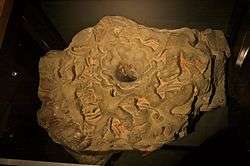Merton Priory
|
A ceiling boss from the Priory, discovered in excavations of Nonsuch Palace, on display in the Museum of London. | |
 Location within Greater London | |
| Monastery information | |
|---|---|
| Established | 1114 |
| Disestablished | 1538 |
| People | |
| Founder(s) | Gilbert Norman, Sheriff of Surrey |
| Important associated figures |
Adrian IV Thomas Becket Walter de Merton |
| Site | |
| Location | Merton, Surrey, England |
| Coordinates | 51°24′52.26″N 0°10′52.58″W / 51.4145167°N 0.1812722°W |

Merton Priory was an English Augustinian priory founded in 1114 by Gilbert Norman, Sheriff of Surrey under King Henry I (1100-1135). It was situated within the manor of Merton in the county of Surrey, in what is today the Colliers Wood area in the London Borough of Merton.
Buildings and holdings
The priory buildings were situated within the Diocese of Southwark and at the point where the River Wandle was crossed by Stane Street, a Roman road, about 10 kilometres (6.2 mi) outside the City of London. It held cultivated land and pastures there and at other places in Surrey and held manors and other lands elsewhere in England including Teign (Canons' Teign) in Devon.[1]
History
By 1117 the foundation had been colonised by Canons Regular from the Augustinian priory at Huntingdon and re-sited in Merton, close to Wandle.[2]
The priory became an important centre of learning and was entered by Nicholas Breakspeare in 1125 (who became Adrian IV, the first English Pope, in 1154), and Thomas Becket in 1130.
Walter de Merton, Lord Chancellor, Bishop of Rochester, and founder of Merton College, Oxford, took his name from the Priory, having been educated there in the 1230s.[2]
In 1236 King Henry III held a Parliament at the Priory at which the Statute of Merton was passed allowing amongst other matters lords of the manor to enclose common land provided that sufficient pasture remained for their tenants. This was the first recorded statute of the first recorded English parliament.
Destruction
The Priory was demolished in 1538, following King Henry VIII's Dissolution of the Monasteries, having been valued in the Valor Ecclesiasticus of 1535 at a relatively high sum of £960 16 shillings 6 pence. Much of the masonry was reused at the king's Nonsuch Palace.[2] The site of the Priory is now occupied by Sainsbury's supermarket (Merton branch). Remains of the Chapter House are now covered by a major road but are accessible from the foot tunnel under Merantun Way, between Sainsbury's and Merton Abbey Mills.
References
- ↑ Risdon, Tristram (d.1640), Survey of Devon, 1811 edition, London, 1811, with 1810 Additions, p.131
- 1 2 3 'Houses of Austin canons: Priory of St Mary of Merton A History of the County of Surrey: Volume 2, ed. H E Malden (London, 1967), pp. 94-102 Accessed 9 April 2015.
External links
| Wikimedia Commons has media related to Merton Priory. |
- The Heritage Trail
- Merton Priory Trust
- Engraving of Merton Priory
- Excavation of Ruins
- BBC video of the site

